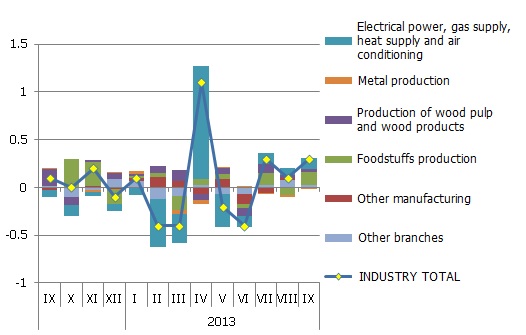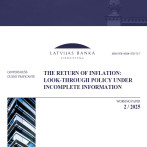No important changes in producer prices
In September 2013, the producer prices in Latvia rose by 0.3% month-on-month. Such a rise was registered both in the domestic market and for production sold as export.
A price rise was observed also year-on-year: in exports by 2.5% and in the domestic market by 0.5%. The producer price dynamic does not create an upward pressure on consumer prices, for the greatest rise was observed in exports and not in the domestic market.
The month-on-month producer price changes in a positive direction in the domestic market were primarily determined by a rise in energy prices (+0.3%), as well as a rise in the producer prices in manufacturing (+0.3%). In contrast to the previous month's drop, the greatest contributor of the manufacturing sub-branches has been the rise in food producer prices (+0.6%). Looking at the producer prices for production sold as exports, we see a price increase in the branches oriented toward the export market, e.g., in the production of wood pulp (+1.0%). The producer prices of exported foodstuffs have also grown by 0.6%.
Year-on-year, the greatest contributor to total producer prices was manufacturing where producer prices rose by 1.9%. The producer prices in wood pulp production grew by 4.4% in total, with the production sold as exports growing most rapidly. The greatest negative contribution was made by the drop in producer prices in the manufacturing of computers and electronic and optical equipment (-18.5%). Year-on-year, the development of producer prices was pronouncedly negative also in garbage collection (-7.6%).
Although a rise in producer prices was observed in Latvia in September, the main raw material prices (global food, oil, metals and wood pulp prices) did not rise substantially or even dropped. The UN Food and Agriculture Organization food price index was last lower than now only in September 2010. It has dropped mostly because of a rapid drop in grain prices, for all other components post small rises in September. Developments in Latvian agriculture do not point to any strong future pressure on food prices. The harvest season ended this year with average or good results in Latvia (albeit worse than last year's outstanding harvest). Branch experts note that the total harvest of grain, for instance, exceeds the average of the last five months by 16%.
Oil prices were relatively high at the beginning of September but started dropping as of the middle of the month, increasing slightly overall month-on-month. Oil prices in October have been stable up to now, without creating any additional pressure on energy prices. A drop in global metals prices has been observed because of continuing weak demand, whereas the prices of wood pulp have stabilized. If the European construction market begins to recover, we may see upward changes in the global wood pulp prices. As a result, wood pulp producer prices might increase even more in Latvia.
Illustration. Month-on-month changes in producer prices and their contributions by branch in the domestic market, percentage points

Source: CSD, Bank of Latvia calculations
Textual error
«… …»






